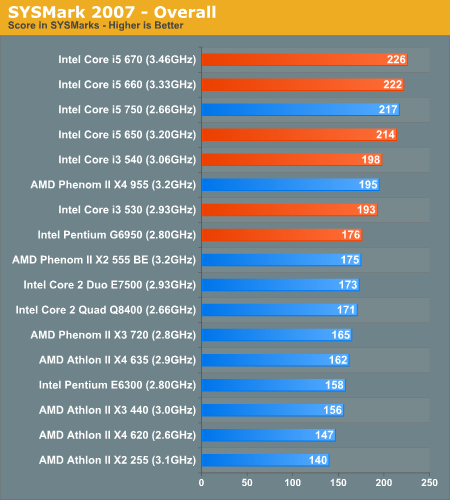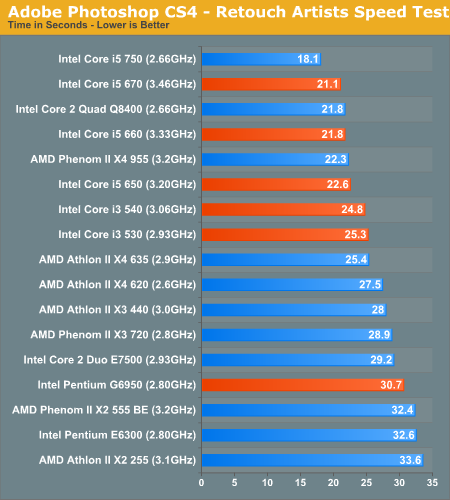The Rest of Clarkdale: Intel's Pentium G6950 & Core i5 650/660/670 Reviewed
by Anand Lal Shimpi on March 24, 2010 4:00 PM EST- Posted in
- CPUs
SYSMark 2007 Performance
Our journey starts with SYSMark 2007, the only all-encompassing performance suite in our review today. The idea here is simple: one benchmark to indicate the overall performance of your machine.

SYSMark ends up being a fairly lightly threaded test, optimized mostly for dual core processors. As such, the Athlon II X3 doesn't really get much benefit from that third core and ends up being more of a Penryn competitor than in the same class as the Core i5/i3 and Pentium G6950.
As a business desktop machine, the Pentium G6950 is a competant option. Clearly slower than the Core i3 530 but not much else. The faster dual core i5s do well here.
Adobe Photoshop CS4 Performance
To measure performance under Photoshop CS4 we turn to the Retouch Artists’ Speed Test. The test does basic photo editing; there are a couple of color space conversions, many layer creations, color curve adjustment, image and canvas size adjustment, unsharp mask, and finally a gaussian blur performed on the entire image.
The whole process is timed and thanks to the use of Intel's X25-M SSD as our test bed hard drive, performance is far more predictable than back when we used to test on mechanical disks.
Time is reported in seconds and the lower numbers mean better performance. The test is multithreaded and can hit all four cores in a quad-core machine.

For a photoshop workstation, Intel's quad-core i5 can't be beat by anything in the i5 lineup - even if you spend more than $200. The Pentium G6950 doesn't do so well here. While it's faster than the Pentium E6300, it's slower than the Core 2 Duo E7500 and AMD's Athlon II X3 440. Photoshop likes to spawn CPU intensive threads and thus Hyper Threading actually matters here. You'll want at least an i5 if you're building a good Photoshop box.










70 Comments
View All Comments
Teloy - Friday, March 26, 2010 - link
"It's GPU still only runs at 733MHz though"... "It's" is not quite right... Take care.8steve8 - Thursday, March 25, 2010 - link
why was the G45 omitted on pg2 in the graph of power consumption under load with integrated graphics?I was keen to see how much more efficient HD graphics were than g45.
-stephen
bpdski - Thursday, March 25, 2010 - link
It would have been nice to see the benchmarks run with the overclocked G6950 also.- Brian
Taft12 - Thursday, March 25, 2010 - link
I have a hard time comprehending what Intel/AMD's TDP ratings mean in light of the "Load Power Consumption" graph.How is it that Intel CPUs with higher TDP ratings consume MUCH LESS power at load than AMD CPUs with lower TDP ratings. Just looks at the results -- all of the Intel core i3/5 CPUs are 73W TDP but the Athlon X2 255 is rated at 65W yet consumes 20 more watts at load. Is the 790FX motherboard that inefficient? WTF???
Lower idle consumption for Intel I understand due to the smaller process and excellent design, but do the TDP ratings truly mean nothing? This is a disastrous result for AMD.
strikeback03 - Friday, March 26, 2010 - link
Both companies rate their TDP differently, and in either case it is not designed to be a measure of power consumption.Nickel020 - Thursday, March 25, 2010 - link
It would be nice if you could include the 661 in the power consumption charts. Does its higher TDP actually lead to higehr power consumption?Sunburn74 - Thursday, March 25, 2010 - link
If you're gonna talk about the value of a 4.4 ghz overclocked processor, you gotta include it the benchmarks. Duh!crochat - Thursday, March 25, 2010 - link
Why the hell is it necessary to always put discrete graphics card in systems with integrated graphics and do power consumption tests with it? Is the benchmark used for power independent from the graphics card?I understand that it is much simpler to measure watts only, but what is important is the resulting task energy consumption, taking into account the efficiency of the processor..
strikeback03 - Friday, March 26, 2010 - link
Because some of the tested systems don't have integrated graphics. So for the application performance comparisons shown to be valid, the discrete GPU has to be kept in there. Wouldn't want someone thinking they could get 69.1 FPS in Crysis Warhead with the power consumption of only the integrated graphics.Taft12 - Thursday, March 25, 2010 - link
It's necessary to save many hours of work the testers could spend on more articles. What counts is the delta in power consumption between CPUs/platforms at idle and load.I'm an AMD fan, but the bottom line is Intel systems are more power efficient, period.